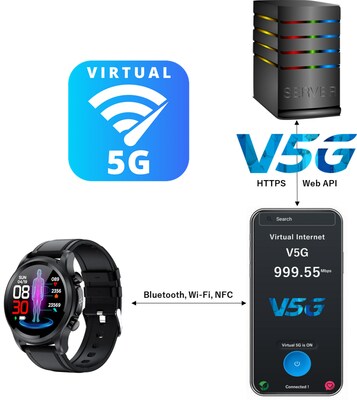Virtual 5G advanced support across all major platforms with wearables
SINGAPORE and SAN JOSE, Calif., Dec. 20, 2023 /PRNewswire/ — Virtual Internet announced that Virtual 5G has now been enhanced to provide increased performance and security for platforms that incorporate wearable technologies. Virtual 5G enhancements are now fully automated and users do not need to make any special configuration changes to enable enhancements for their wearables. Virtual 5G enhancements allow wearables to deliver on their promise and purpose.
These wearable devices, such as Smartwatches, use dedicated biosensors to determine health and fitness metrics, but rely on phones and tablets with apps which communicate with systems in the cloud. Smartwatches typically communicate with Smartphones via Bluetooth, and NFC, however Wi-Fi, 3G, and 4G/LTE is being increasingly used to connect watch/wearable to phone.
Virtual 5G now supports the most widely used platforms such as Wear OS (formerly Android Wear) a version of Google’s Android operating system designed for Smartwatches and other wearables, Apple watchOS, the operating system of the Apple Watch, based on iOS, the operating system used by the iPhone, and Zepp OS, Amazons Amazfit’s fitness watches which also require a Smartphone and works with iPhones and Android phones equally.
Technological advancement in wearable health devices has developed low-consumption and high-integration sensor technology with low-power high-performance battery technology and high processing chip technology. Consumer Wearables are increasingly attempting to determine useful health and fitness metrics. Wearable Health Devices (WHDs) are an emerging technology that enables continuous ambulatory monitoring of human vital signs. While some sensors, Altimeters, Pedometers, Barometers, Thermometers, etc., are accurate; however, the sensors used for Health and Medical purposes, Heart sensors, Blood sensors, and Temperature sensors which are more critical, are often less accurate.
Wearables Need more than an App – they need a 5G Global Network
Wearable Device sensors need connection to the network, yet Network issues of Bandwidth, Security, Privacy and Performance impact the utility of Wearable Health Devices. Virtual 5G enhancements for Wearables now eliminate the Network issues that impact wearable connections to Cloud Based Medical grade systems for collection, analysis, correlation, correction, decision making, and interventions.
Wearable Medical Information Data Accuracy and the Cloud
As wearable technologies are being increasingly used for clinical research and healthcare, it is critical to understand their accuracy varies; measurement errors may impact healthcare decision-making. Accuracy of wearable technologies has been a hotly debated topic in the medical community. Wearable technology companies are responsible for assessing and reporting the accuracy of their products. For example, Heart rate measurements from wearables are derived from photoplethysmography (PPG), an optical method for measuring changes in blood volume under the skin, where potential inaccuracies in PPG stem from three major areas, includes (1) diverse skin tones/types, (2) motion artifacts, and (3) signal crossover. Studies have shown significant differences between devices, between activity types, with absolute errors during activity that were on average 30% higher than during rest periods. Varying accuracy exists between different wearables through varying changes in activity, with implications for clinicians, and consumers in making health-related decisions using these devices.
Wearable Personalized Medical Information Data Privacy, Security and the Cloud
Personalized data generated from Wearables creates significant risks in Privacy, Security and Anonymity over Public communication networks. Wearables are driven by device operation, not the data or the sensitive nature of the data itself which is likely the most personal and private data that exists. However, there are no global laws that limit what can be collected, shared, stored or analyzed, with different standards on device security, differing levels of authentication and authorization, and different ethics on data collection worldwide. Certainly, there are no global security and privacy guarantees regarding how devices collect, send and analyze data, other than what the users employ to protect themselves, their families, friends and loved ones.
Wearable Data Accuracy and the Cloud
Wearable Medical Measurements have error rates that average 30%. This means the Network is the critical component for connecting to Cloud based systems to correlate, validate, and correct data and medical determinations, the primary value of Wearable Health Devices.
Virtual 5G has now implemented prioritization for Web-based data, such as from Device-to-Phone-to-Cloud over the Network, to enable the High Bandwidth networking needed for the myriad of medical sensor data that comprises real-time continuous ambulatory monitoring of human vital signs during daily life.
Wearable Data Privacy, Security and the Cloud
Virtual 5G has now implemented enhanced security and encryption of Web-based data, the data from Device-to-Phone-to-Cloud over the Network, to enable Highly Secure networking that is not just Private, it is Invisible. Virtual 5G specifically enables Transmission Anonymity, which protects users from security deficiencies in their wearable’s platform, and vulnerabilities in their service providers networks, allowing users to guarantee the protection of themselves, their families, friends and loved ones.
Wearable Remote Monitoring and the Cloud
The human body has multiple different physiological signs that can be measured. These are extracted in real time for Anomaly Detection, Prediction, and Potentially Life Saving Medical Intervention. The real-time continuous monitoring speaks to the need for High-Performance Networking to communicate these alerts to clinicians.
Virtual 5G has now implemented enhanced low latency for Web-based data, such as from Device-to-Phone-to-Cloud over the Network, to enable the High-Performance networking needed for real time remote monitoring and decision making. Virtual 5G enhancements allow wearables to deliver on their promise and purpose.
About Virtual Internet Pte. Ltd.
Virtual Internet is a metaverse company, incorporated in Singapore. Virtual Internet is building a new community of millions of users, connected through multiple networks. Virtual Internet has created and operates on its own Virtual 5G Global Overlay Network, which allows millions of other applications and services to be delivered over 5G Mobile Broadband Speeds using existing Cellular Radio, Wi-Fi, and SATCOM networks.
Media Contact:
[email protected]
![]() View original content to download multimedia:https://www.prnewswire.com/news-releases/virtual-internet-announces-virtual-5g-enhanced-networking-in-support-of-wearable-device-technology-302020442.html
View original content to download multimedia:https://www.prnewswire.com/news-releases/virtual-internet-announces-virtual-5g-enhanced-networking-in-support-of-wearable-device-technology-302020442.html
SOURCE Virtual Internet Pte. Ltd.



